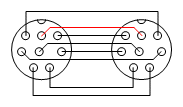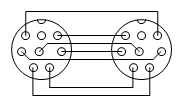There seems to be many standards of mac serial cables and interesting that many of them has come
with software disk. Does anybody have names of them and files from those disks?
I give some of information that I know and I don't know.
Cable type 1, Direct to instruments Host port with pin7 connected:
- Yamaha CJJMac,

, Is this with disk? Also sold with product number M0197, without disk. Early devices (example TG100) use 1Mhz clock 8 bit, 1 Stop, No parity format.
- Korg AG-002/AG-002B, cable is same that CJJMac, comes with disk that has Apple Midi Manager driver updated by Korg(in year 1999!). I want files from that disk!
Cable type 2, Direct to instruments Host port without pin7 connected:
- Roland RSC-15APL,

, No disk, but Roland is has still mac serial drivers for download.
- Kawai (product name unknown), cable is same as Roland, disk might have something interesting, because K11 support 32 midi channels with it.
Cable 3 type, Crosswired to MIDI Interface:
- MOTU
- Opcode
- Midiman
- Emagic
Cable 4 type, Direct cable to MIDI Interface:
Maybe there is not any this kind of cable for MIDI use.
More information needed what cable type and what is on the disk:
- GEM (General Music) Multimedia Kit Mac, Direct to host port cable, but what type? It has disk, but what files??
All another information is also welcome about serial cables.
EDIT:Updated with information from GaryN
EDIT2: Little more information about Yamaha Host cable


